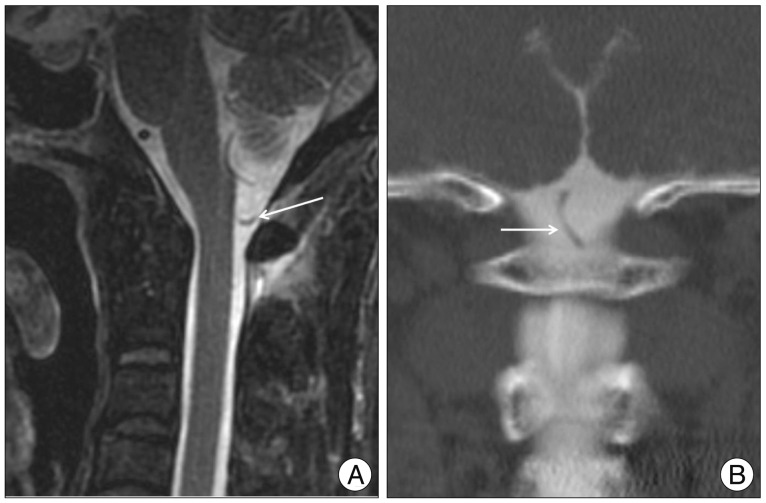J Korean Neurosurg Soc.
2013 Sep;54(3):268-271. 10.3340/jkns.2013.54.3.268.
Intractable Occipital Neuralgia Caused by an Entrapment in the Semispinalis Capitis
- Affiliations
-
- 1Department of Neurosurgery, Seoul St. Mary's Hospital College of Medicine, The Catholic University of Korea, Seoul, Korea. sbc@catholic.ac.kr
- 2Department of Neurosurgery, St. Vincent's Hospital, College of Medicine, The Catholic University of Korea, Seoul, Korea.
- 3Catholic Neuroscience Institute, College of Medicine, The Catholic University of Korea, Seoul, Korea.
- KMID: 2190913
- DOI: http://doi.org/10.3340/jkns.2013.54.3.268
Abstract
- Occipital neuralgia is a rare pain syndrome characterized by periodic lancinating pain involving the occipital nerve complex. We present a unique case of entrapment of the greater occipital nerve (GON) within the semispinalis capitis, which was thought to be the cause of occipital neuralgia. A 66-year-old woman with refractory left occipital neuralgia revealed an abnormally low-loop of the left posterior inferior cerebellar artery on the magnetic resonance imaging, suggesting possible vascular compression of the upper cervical roots. During exploration, however, the GON was found to be entrapped at the perforation site of the semispinalis capitis. There was no other compression of the GON or of C1 and C2 dorsal roots in their intracranial course. Postoperatively, the patient experienced almost complete relief of typical neuralgic pain. Although occipital neuralgia has been reported to occur by stretching of the GON by inferior oblique muscle or C1-C2 arthrosis, peripheral compression in the transmuscular course of the GON in the semispinalis capitis as a cause of refractory occipital neuralgia has not been reported and this should be considered when assessing surgical options for refractory occipital neuralgia.
Figure
Reference
-
1. Bogduk N. The clinical anatomy of the cervical dorsal rami. Spine (Phila Pa 1976). 1982; 7:319–330. PMID: 7135065.
Article2. Bovim G, Bonamico L, Fredriksen TA, Lindboe CF, Stolt-Nielsen A, Sjaastad O. Topographic variations in the peripheral course of the greater occipital nerve : Autopsy study with clinical correlations. Spine (Phila Pa 1976). 1991; 16:475–478. PMID: 2047922.
Article3. Bovim G, Fredriksen TA, Stolt-Nielsen A, Sjaastad O. Neurolysis of the greater occipital nerve in cervicogenic headache. A follow up study. Headache. 1992; 32:175–179. PMID: 1582835.
Article4. Cornely C, Fisher M, Ingianni G, Isenmann S. Greater occipital nerve neuralgia caused by pathological arterial contact : treatment by surgical decompression. Headache. 2011; 51:609–612. PMID: 21457245.
Article5. Ehni G, Benner B. Occipital neuralgia and the C1-2 arthrosis syndrome. J Neurosurg. 1984; 61:961–965. PMID: 6491740.
Article6. Gille O, Lavignolle B, Vital JM. Surgical treatment of the greater occipital neuralgia by neurolysis of the greater occipital nerve and sectioning of the inferior oblique muscle. Spine (Phila Pa 1976). 2004; 29:828–832. PMID: 15087807.
Article7. Hammond SR, Danta G. Occipital neuralgia. Clin Exp Neurol. 1978; 15:258–270. PMID: 756019.8. Headache Classification Subcommittee of the International Headache Society. The International Classification of Headache Disorders, 2nd edition. Cephalalgia. 2004; 24(Suppl 1):9–160. PMID: 14979299.9. Kuhn WF, Kuhn SC, Gilberstadt H. Occipital neuralgias : Clinical recognition of a complicated headache. A case series and literature review. J Orofac Pain. 1997; 11:158–165. PMID: 10332322.10. Magnússon T, Ragnarsseon T, Björnsson AO. Occipital nerve release in patients with whiplash trauma and occipital neuralgia. Headache. 1996; 36:32–36. PMID: 8666535.
Article11. Mosser SW, Guyuron B, Janis JE, Rohrich RJ. The anatomy of the greater occipital nerve : implications for the etiology of migraine headaches. Plast Reconstr Surg. 2004; 113:693–697. PMID: 14758238.
Article
- Full Text Links
- Actions
-
Cited
- CITED
-
- Close
- Share
- Similar articles
-
- Fluoroscopy and Sonographic Guided Injection of Obliquus Capitis Inferior Muscle in an Intractable Occipital Neuralgia
- Diagnosis and treatment of occipital neuralgia: focus on greater occipital nerve entrapment syndrome
- Referred Trigeminal Pain from Greater Occipital Nerve Entrapment: Importance of Accurate Greater Occipital Nerve Decompression
- Permanent Peripheral Nerve Stimulation for Chronic Occipital Neuralgia: Case reports
- Cervical Myelitis Mimicking Intractable Occipital Neuralgia



